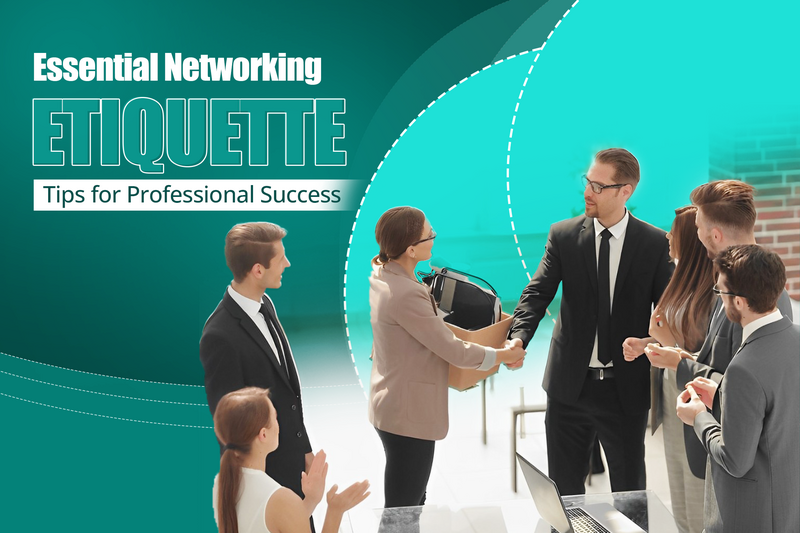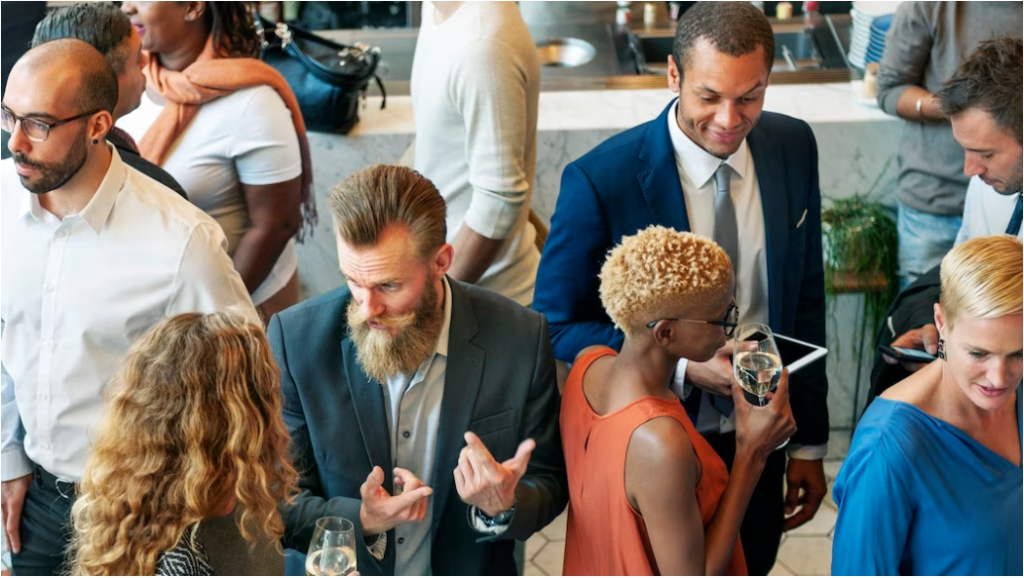
Today, networking is an essential part of one’s professional life. It helps professionals build their connections and advance their careers and businesses. However, if you want to excel at networking, you may have to shift your focus beyond exchanging business cards or sending Linkedin connections.
If you wish to create long-lasting professional connections, foster trust, and build genuine relationships, you must understand and practice sound networking etiquette. In this article, we will examine some of these networking etiquette tips and their importance in navigating the tumultuous landscape of professional connections in 2024.
Significance of Networking Etiquette
Interpersonal relationships are everything when it comes to networking. When interacting with people, one must be mindful of one’s body language, tone of voice, words, and actions, among other things. Attending a networking event should result in building meaningful relationships. That’s why it’s important to adhere to some basic rules of etiquette that will ensure everyone has a good time. They will ensure you make the most of your networking experience.

One of the most important things to do at a networking event is to establish and maintain healthy boundaries while interacting with your industry peers. At such events, one’s first impression is everything. People often get disappointed with networking events because most event-goers come across as aggressive self-promoters or sellers, which can result in many unwanted awkward interactions. That’s why adhering to a set of networking etiquette is important.
Let’s look at a few networking etiquette rules/tips to help individuals navigate professional settings in 2024 with just the right amount of confidence and grace.
7 Essential Networking Etiquette Tips To Help You Make Lasting Professional Connections
Here are a few tips that will enhance your networking skills and help you build authentic professional relationships, foster trust, and approach networking conscientiously.
1. Make a Memorable First Impression
Networking events can often be quite intimidating. However, with a little guidance, you’ll surely be able to navigate the challenging waves of networking at an event. If you are attending a networking conference, or any event for that matter (with a viewpoint to build a solid network), you must be mindful of making a good first impression.
How you interact with someone in the first few minutes of meeting them determines the rest of your conversation. That’s why you must make the most of every opportunity. Here are some of the ways in which you could build a great first impression.
i) Dress to Impress: An American costume designer, Edith Head, once said, “You can have anything you want in life if you dress for it.” Indeed. If you dress well at a networking event, you will surely garner people’s attention and get them to take you seriously without much persuasion.
When selecting an outfit to wear, always remember the dress code for the event. If it’s a formal event, opt for a formal outfit like a professional-looking suit, tailored dress, or a pantsuit. If it’s a semi-formal event, you can choose attires that perfectly blend casual and formal. For instance, a white button-down shirt with bootcut or slim-fit jeans and a versatile blazer or khakis with a formal top, the color of which complements your skin tone. To know about what to wear at an event in detail, read our article, ‘A Comprehensive Guide On What To Wear To A Conference For Men & Women.’
ii) Be On Time: Conferences and events operate on a strict schedule to stay on track. If one of your priorities is building connections, it helps if you arrive a little earlier than expected. If you arrive late to the event, you will not only miss out on the event but also risk not being taken seriously by your peers and the delegates.
iii) Pay attention to your Body Language, Tone, and Words: Deborah Bull, a member of the House of Lords of the United Kingdom, very rightly said, “Body language is a very powerful tool. We had body language before we had speech, and apparently, 80% of what you understand in a conversation is read through the body, not the words.”
While you must be mindful of the words you use to address your peers and connections when initiating a conversation, you must also pay attention to your body language. For instance, you should have good posture, a straight back, a warm smile, gentle but firm eye contact, an earnest handshake, and attentive eyes when approaching your fellow delegates to exude confidence and warmth.
While speaking, also ensure you vary your tone and intonation as per the conversation you are having. In short, your words must be backed with the right kind of energy and body language to make you appear more open and trustworthy.
iv) Practice an elevator pitch: Practicing an elevator pitch before approaching people at a networking event is crucial when it comes to building a solid first impression. It also acts as a great conversation starter. It provides a clear and concise summary of who you are, what you do, and what you bring to the table. This brevity is essential in networking settings where time is limited, ensuring you can effectively communicate your message in a brief encounter. If you practice it beforehand, you can refine your pitch to be engaging, memorable, and tailored to your audience, leaving a positive impression from the outset.
v) Avoid distractions: This is the most relevant networking tip today. Nothing is more disrespectful than being on your phone or looking elsewhere while speaking to someone. Ensure you always look at the person you speak with when you meet them. Failure to do so may result in losing that conversation and the contact forever.
2. Initiate and Sustain Authentic and Engaging Conversations

A few tips that could help you on the path of being your authentic and engaging self in social interactions could include:
i) Have a purpose: Having a clear purpose before attending a networking event or conference will help you stay true to your path and nudge you to stay focused on people and conversations that align with your goals and values. It will also prevent you from wasting your time and energy on impertinent topics and forceful small talk.
ii) Stay curious and perceptive to others’ needs: When you listen more than you speak at an event, you are more likely to establish a strong rapport with others. Practicing active listening and following up with relevant information and insights is a great way to establish authentic networking relationships.
Be appreciative of others and have conversations that add value to them and you. It could involve you solving a problem for them, giving them constructive feedback about something they are working on, or appreciating them and their work.
iii) Embrace vulnerability: Tapping into one’s vulnerability can help one be one’s authentic self in social interactions. While interacting with your peers at a networking event, don’t shy away from talking about your professional wins and losses. Of course, ensure you don’t overshare or make it all about yourself, but a well-balanced approach backed with purpose and intent in your discussions will definitely help bring out your authentic self.
Mental health advocate and networking expert Nick Jonsson is very vocal about embracing authenticity while networking. “Authenticity in networking blossoms when we embrace vulnerability, sharing not just triumphs but also our struggles. My journey is a testament to this. I openly share my life’s challenges and failures, revealing my humanity and connecting deeply with others. This vulnerability paved the way for us to discuss how I overcame these hurdles, leading to a life beyond my wildest dreams. My story inspires and underscores the power of leading with vulnerability – it’s the secret to genuine connections,” he writes on Linkedin.
However, it’s important to note that, like any skill, being authentic also requires much practice. If you’re not used to attending events, let alone making connections, chances are you may not ace it right away. Some people take time to be themselves around people they haven’t met before and take longer than usual to share their journey with others and make long-lasting connections.
It’s best to go easy on yourself and treat it like any other skill you’re trying to learn, as forcing yourself too much can push you to come across as if you’re trying too hard to fit in, which is counterproductive.
3. Know How to Exit Conversations Politely
While initiating a conversation at a networking event is important, knowing how to exit a conversation is just as important, if not more. You may experience that a conversation could start off well but may fail to keep you engaged for a long period of time. It may get boring or fail to take the direction that you expect.
Knowing how to move on from a conversation politely is an important life skill to have that isn’t given enough credit these days. When done tactfully, a successful exit from a conversation goes a long way.

Pic Courtesy: Freepik
So here are some examples of how to end a conversation at your next networking event.
- i) “Well, it was lovely meeting you today. I really enjoyed our conversation and look forward to continuing our connection even after the event.”
- ii) “XYZ, it’s been a pleasure catching up with you, but I am afraid I have to take your leave. I need to meet with ABC before she leaves. Let’s connect over coffee in a few days.
- iii) It was great meeting you today. We had some valuable discussions that I will revisit. I need to meet Mr. XYZ from ABC, who is here just for this session. Once again, thank you so much for the engaging conversation.
- iv) I have to excuse myself, so sorry. It was lovely meeting you today. And thanks for your card. I shall surely get in touch with you.
4. Give Equal Importance to Digital Networking Etiquette
Networking etiquette is important for both in-person and virtual events. Interacting and networking can be tricky when you’re not in the same physical space as others. The pandemic forced event professionals to shift the event space online, which naturally led everyone to adapt and follow appropriate networking etiquette for seamless virtual networking.
Digital etiquette, typically known as “netiquette,” emphasizes the importance of proper manners and behavior online. Generally speaking, the underlying message to participants attending a virtual networking event or maintaining a sound digital presence is to be kind and respectful to one another. For a list of etiquette to follow during online meetings, read our article, Virtual Meeting Etiquette: 15 Must-Follow Tips for Professionals Everywhere.
Even if the events don’t occur online that often, having a sound social media presence is important. Ensure you always maintain a professional and poised image on social media platforms, like Linkedin, Facebook, and Instagram, to name a few, as it is usually a stepping stone to building long-lasting connections at events and conferences.
5. Respect Personal Space and Boundaries
Networking events are designed so that you constantly meet and interact with people to build long-lasting connections—at least, that’s the idea. However, nothing can put off people more than those who are not respectful of one’s personal space and boundaries.

Pic Courtesy: Freepik
Let’s look at a few tips on how we can be respectful of people’s boundaries.
i) Ask people before approaching them: It is considered rude to approach someone at an event and start talking without heeding that they may be busy or choosing to stay aloof. That’s why it is best to ask one if they are with someone or if you could join them before starting to interact with them.
Femke (de Bruin) Cornelissen, a technical evangelist, believes one must always ask people before approaching them. In a post on Linkedin, she writes, “My advice is to ask people who are alone if they want to join you and others in a conversation. When you are alone, always search for people who are alone or people who are with more than two people. The chance that they talk about private things is lower. People are also there (at the event) to network. Make that step forward, and go for it! “
ii) Avoid standing or sitting too close to people: When interacting with people, it’s crucial to be mindful of their space boundaries. It’s important not to invade their space and always to respect their comfort levels. This awareness is vital to behave in a way that fosters comfort and shows respect. Furthermore, it’s necessary to refrain from saying or doing anything that could make others feel uneasy or uncomfortable around you.
iii) Avoid asking personal questions: At networking events, people gather to make connections and talk about business matters. It’s important to avoid questions that could intrude on someone’s privacy and make them feel uneasy. Sticking to discussions about work-related subjects helps uphold a professional environment.
iv) Don’t eavesdrop on other people’s conversations: Do not eavesdrop on other people’s conversations at a networking event or conference. Actively listening to private conversations without permission is disrespectful, distasteful, and not a mark of professionalism. If you wish to participate in the conversation, ask if you could contribute, and then feel free to participate openly in the ongoing discussion. This will help you build trust, credibility, and a solid first impression with your fellow attendees.
6. Show Gratitude and Appreciation
Once the event is over, ensure you remember to say thank you to your connections for their time, valuable input, advice, and assistance. It can be a simple written note or a small gift to show them your appreciation. Acknowledging their contributions and thanking them for the wonderful time they had with them at the event will help strengthen their relationship and leave a positive impression.
Apart from sharing thank you notes and expressing your gratitude in words, here are some other tips in which you can show gratitude and appreciation to your fellow attendees/ participants.

i) Be Ready to Offer Assistance: One of the best ways to show gratitude or appreciation to fellow participants is to be willing to help them in any way possible. If you can also share resources or inputs that may benefit them, it will help establish a rapport that will last long after the event is over.
ii) Be Willing to Share Resources: If you come across something, say an important resource or piece of information that can help your fellow participants at the event, don’t shy away from sharing it with them. This will demonstrate your willingness to help them beyond the confines of the event, which is a huge stepping stone for a long-lasting professional connection.
iii) Follow Up on Certain Tasks Post the Event: If you discuss some specific topics during the event, ensure you follow up with your fellow participants even after the event is over. When you follow up with your fellow participants, it shows that you value their input and the opportunity to collaborate with them.
iv) Give Shout-Outs on Social Media: Use the opportunity to connect with your fellow attendees and give them a shout-out on social media platforms to thank them for their contributions and insights, which have helped you grow professionally. Tagging them to relevant posts or sharing their content can help establish rapport with them.
v) Provide Recommendations and Referrals: Never miss an opportunity to recommend or refer someone you met at an event or conference. Referrals are a powerful way to express your gratitude and appreciation to your fellow attendees and help you come across as a credible and trustworthy professional connection that they will continue to value and foster for years to come. Over a period of time, it will also help you and your connection build a strong and lasting community in your respective industry.
7. Follow Up With Fellow Attendees After The Event to Foster Connection
Meeting and interacting with fellow attendees is only half the battle won. Perhaps the most challenging aspect of networking, especially business networking, is following up promptly after the event is over to sustain that connection for a long time. After all, the whole point of attending a professional networking event is to build long-lasting relationships.
So how does one sustain these relationships? You can either send a thank-you email or connect with them on professional networking platforms like LinkedIn to keep the conversation and relationship going.

If you’re sending them an email, praise them for their participation and let them know that you highly appreciated their attendance. You should specifically highlight their contribution to your professional growth and development and let them know they are always welcome.
If you are an organizer who is sending a thank-you email to important event stakeholders after the conclusion of a successful event, include a Call-to-Action at the end along with a link to a survey or a feedback form. You can also request testimonials to get participants’ input on better ways to conduct the events in the future.
Some other tips for following up with fellow attendees/ important stakeholders after an event or conference include:
i) Personalize your email with specific details: Personalize your follow-up emails by remembering particular discussions or themes discussed during the event. This will prove that you paid attention and had a sincere desire to know their ideas. Let them remember any common interests, goals, or obstacles you mentioned during the event. This will rejuvenate the conversation and ensure continuity in the relevance of your acquaintanceship.
Sample Email:
Subject: Following Up on our Conversation: [Specific Topic/Theme Discussed]
Dear [Name],
I hope this email finds you well. It was a pleasure meeting you at [Name of Event] and engaging in our insightful conversation about [specific topic or theme discussed]. Your perspectives and ideas were truly inspiring, and I appreciated the opportunity to exchange thoughts with someone as knowledgeable as yourself.
I particularly enjoyed discussing [mention a specific point or insight from your conversation]. Your insights into [specific aspect of the topic] really resonated with me, and I’ve been reflecting on our conversation since the event.
Furthermore, I wanted to revisit some of the common interests and goals we discovered during our discussion. Our shared passion for [mention common interest or goal] and our mutual desire to overcome [mention shared obstacle or challenge] stood out to me as areas where we could potentially collaborate or support each other moving forward.
I believe there is great potential for us to continue our conversation and explore ways to collaborate or exchange ideas further. Would you be interested in scheduling a follow-up call or meeting to delve deeper into [specific aspect of the topic] or explore potential collaboration opportunities?
Please let me know your availability, and I’ll be more than happy to coordinate a time that works for both of us.
Thank you once again for the engaging conversation at [Name of Event]. I look forward to continuing our dialogue and exploring areas of mutual interest.
Warm regards,
[Your Name]
[Your Position/Company]
[Your Contact Information]
ii) Propose Next Steps: Offer specific suggestions for pursuing or expanding the ideas discussed at the event. Whether it’s making a new appointment, exchanging contacts, scheduling interviews, attending future trade shows/conferences/events together, or discussing the potential for synergy, clarity on the next steps is always the key.
iii) Be Authentic and Respectful of their time in your Follow-Ups: Maintain genuineness by using personalized responses rather than automated templates. Authenticity gives rise to trust and builds a solid professional bond framework. Keep your correspondence straightforward and concise. Appreciate their tight schedules by avoiding sending long texts or bombarding them with redundant information.
iv) Follow Through On Your Promises: One important aspect of following up on the event is fulfilling any promises or agreements made at the event. This helps create a perception of reliability and professionalism, build a credible image, and ensure that they know you value them.
Key Takeaway
Networking etiquette does not just present a mere opportunity to get acquainted with new people; it helps in building a strong sense of professionalism, mutual rapport, respect, and authenticity. By applying the principles discussed, you will successfully interact with people and give yourself an opportunity for growth. These guidance tips will also help you stand out in such professional networking gatherings.
As you embark on the journey to expand your professional network this year, remember that networking is far from just a mechanical swap of business cards. It’s an opportunity to cultivate valuable connections that can enrich your personal and professional life. Authentically and honestly approach each networking opportunity, and you will see that you’ve naturally grown your network, which will, as a result, open up many doors of new professional collaborations and work opportunities.





Comments are closed.